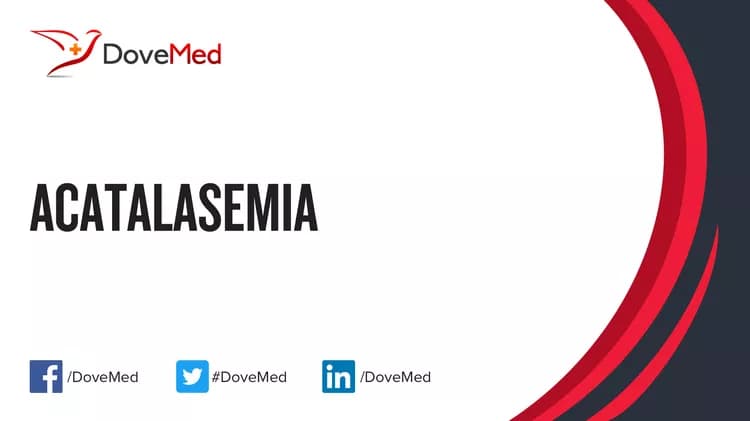What are the other Names for this Condition? (Also known as/Synonyms)
- Acatalasia
- Catalase Deficiency Disorder
What is Acatalasemia? (Definition/Background Information)
- Acatalasemia is a congenital disorder resulting from a deficiency in erythrocyte catalase, an enzyme responsible for the breakdown of hydrogen peroxide
- The disorder is usually asymptomatic but may be associated with oral ulcerations and gangrene, or diabetes mellitus and atherosclerosis in certain populations
- Transmission is autosomal recessive
(Source: Acatalasemia; Orphanet, National Institute of Health and Medical Research (INSERM), Paris.)
Who gets Acatalasemia? (Age and Sex Distribution)
- Acatalasemia is a rare congenital disorder with incidence of 1 in 31,250 (general population)
- The presentation of symptoms may occur at birth
- Both males and females may be affected
- Worldwide, individuals of all racial and ethnic groups may be affected
(Source: Acatalasemia; Orphanet, National Institute of Health and Medical Research (INSERM), Paris.)
What are the Risk Factors for Acatalasemia? (Predisposing Factors)
- A positive family history may be an important risk factor, since Acatalasemia can be inherited
- Currently, no other risk factors have been clearly identified for the condition
It is important to note that having a risk factor does not mean that one will get the condition. A risk factor increases one’s chances of getting a condition compared to an individual without the risk factors. Some risk factors are more important than others.
Also, not having a risk factor does not mean that an individual will not get the condition. It is always important to discuss the effect of risk factors with your healthcare provider.
What are the Causes of Acatalasemia? (Etiology)
- The cause of development of Acatalasemia is unknown
- It is reportedly a genetic disorder that is inherited in an autosomal recessive manner
Autosomal recessive: Autosomal recessive conditions are traits or disorders that occur when two copies of an abnormal gene have been inherited on a non-sex chromosome. If both parents have an autosomal recessive condition, there is a 100% likelihood of passing on the mutated genes to their children. If, however, only one mutant copy of the gene is inherited, the individual will be a carrier of the condition, but will not be present with any symptoms. Children born to two carriers, have a 25% chance of being homozygous dominant (unaffected), a 50% chance of being heterozygous (carrier), and a 25% chance of being homozygous recessive (affected).
What are the Signs and Symptoms of Acatalasemia?
The disorder is usually asymptomatic but may be associated with oral ulcerations and gangrene, or diabetes mellitus and atherosclerosis in certain populations.
The signs and symptoms of Acatalasemia may include:
- Reduced catalase activity
- Oral ulcer
(Source: Acalvaria; Genetic and Rare Diseases Information Center (GARD) of National Center for Advancing Translational Sciences (NCATS), USA.)
How is Acatalasemia Diagnosed?
Acatalasemia is diagnosed on the basis of the following information:
- Complete physical examination
- Thorough medical history evaluation
- Assessment of signs and symptoms
- Laboratory tests
- Imaging studies
- Biopsy studies, if necessary
Many clinical conditions may have similar signs and symptoms. Your healthcare provider may perform additional tests to rule out other clinical conditions to arrive at a definitive diagnosis.
What are the possible Complications of Acatalasemia?
The complications of Acatalasemia may include:
- Diabetes associated complications
- Heart conditions due to atherosclerosis
Complications may occur with or without treatment, and in some cases, due to treatment also.
How is Acatalasemia Treated?
There is no cure for Acatalasemia, since it is a genetic condition. The treatment is usually given to manage the signs and symptoms and any complications that develops.
How can Acatalasemia be Prevented?
Currently, Acatalasemia may not be preventable, since it is a genetic disorder.
- Genetic testing of the expecting parents (and related family members) and prenatal diagnosis (molecular testing of the fetus during pregnancy) may help in understanding the risks better during pregnancy
- If there is a family history of the condition, then genetic counseling will help assess risks, before planning for a child
- Active research is currently being performed to explore the possibilities for treatment and prevention of inherited and acquired genetic disorders
Regular medical screening at periodic intervals with tests and physical examinations are recommended.
What is the Prognosis of Acatalasemia? (Outcomes/Resolutions)
- The prognosis of Acatalasemia is dependent upon the severity of the signs and symptoms and associated complications, if any
- Individuals with mild conditions have better prognosis than those with severe symptoms and complications
- Typically, the prognosis may be assessed on a case-by-case basis
Additional and Relevant Useful Information for Acatalasemia:
The following DoveMed website link is a useful resource for additional information:
Related Articles
Test Your Knowledge
Asked by users
Related Centers
Related Specialties
Related Physicians
Related Procedures
Related Resources
Join DoveHubs
and connect with fellow professionals


0 Comments
Please log in to post a comment.